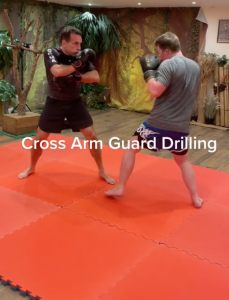Punches from the Cross Arm Guard (diary entry)
- jamie03066
- Jan 11, 2023
- 3 min read

10.01.2023 Tuesday night's lesson, hour six of my client's second current boxing course, was totally technical in nature. Once we had revised Cuban boxing footwork drills as part of the warm-up we got straight into throwing boxing's basic punches from the cross-arm guard. The first thing to remember about the cross-arm guard is that its purpose suits the counter-puncher. This is why the likes of clinical sluggers such as Max Schmeling used it a lot in his defence. Archie Moore, the master of the cross-arm guard, based most of his complex strategies from counter-fighting and the guard was his main base of operations. It's a patient fighter's guard, used to set traps and throw punches after an opponent has committed to their attack. Jab - The conventional cross-arm guard has the jabbing arm in the bottom position. In order to throw a basic jab or most varieties of jabs, the fighter either has to switch back to a more typical boxing guard or perform some other cumbersome movement that will telegraph the punch. At long range the cross-arm fighter will typically go to a generic low guard and freely throw jabs. In this respect, the Philly Shell evolution of the cross-arm guard provides more obvious jabbing opportunities. Cross-arm jabs thrown from mid-range need take the form of an up-jab/flicker jab hybrid. The fighter needs to cover in an angled position as he would throw an up-jab and then launches the jab as if they were executing a back-fist. This part is similar to the way the flicker jab is thrown, sideways off the elbow, but at the last moment the punch is then pushed out so that it becomes a legitimate jab. As with all jabs, it can be thrown offensively but we drilled it off the shoulder roll. Rear Straight - This is probably the most obvious comfortable punch to throw off the cross-arm guard. It suits the shoulder roll/rear hand catch technique extremely well. The right hand is already cocked and ready to go having to travel a shorter distance it would if it was held in a conventional guard. Again, we drilled it off the shoulder rolling both jabs and straights. Lead Hook - Unless the technique is thrown at close range, where the cross-arm guard comes into its own using the rear arm to frame or post, or the aforementioned long range from a low guard or Philly Shell the lead hook has similar problems to the jab. Again, understanding the nature of the guard and its strategies provides us with the solution. The lead hook at mid-range is best executed whilst blocking/catching a lead hook or when slipping a straight punch or weaving under a rear hook or haymaker. Here I found the Cuban footwork points were useful. The fighter simply has to pivot the back-foot in to defend and then out to throw the hook. A similar principle might be followed with the lead uppercut. Rear Uppercut - I find the Cuban vertical uppercut to be a very comfortable fit with the cross-arm guard. The hand is already in position and the rear foot can pivot in. The torso twists in an upward motion. A normal uppercut can also be thrown, although the hand needs to rotate later than normal. We trained it off the shoulder roll/rear hand catch, countering straight punches and it can also be used weaving against a lead hook or haymaker. https://clubbchimera.com/services/













Comments